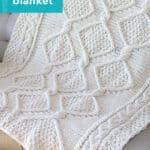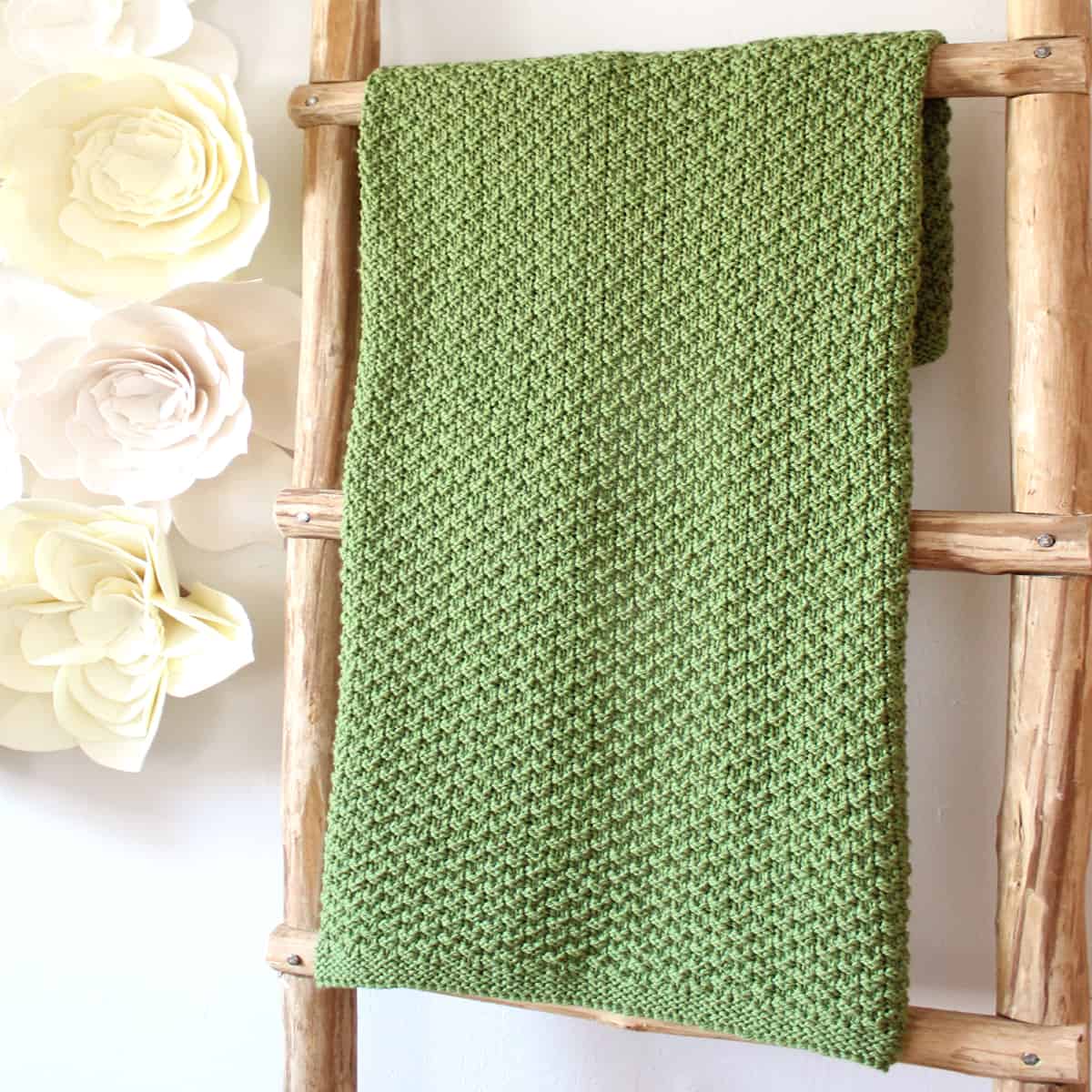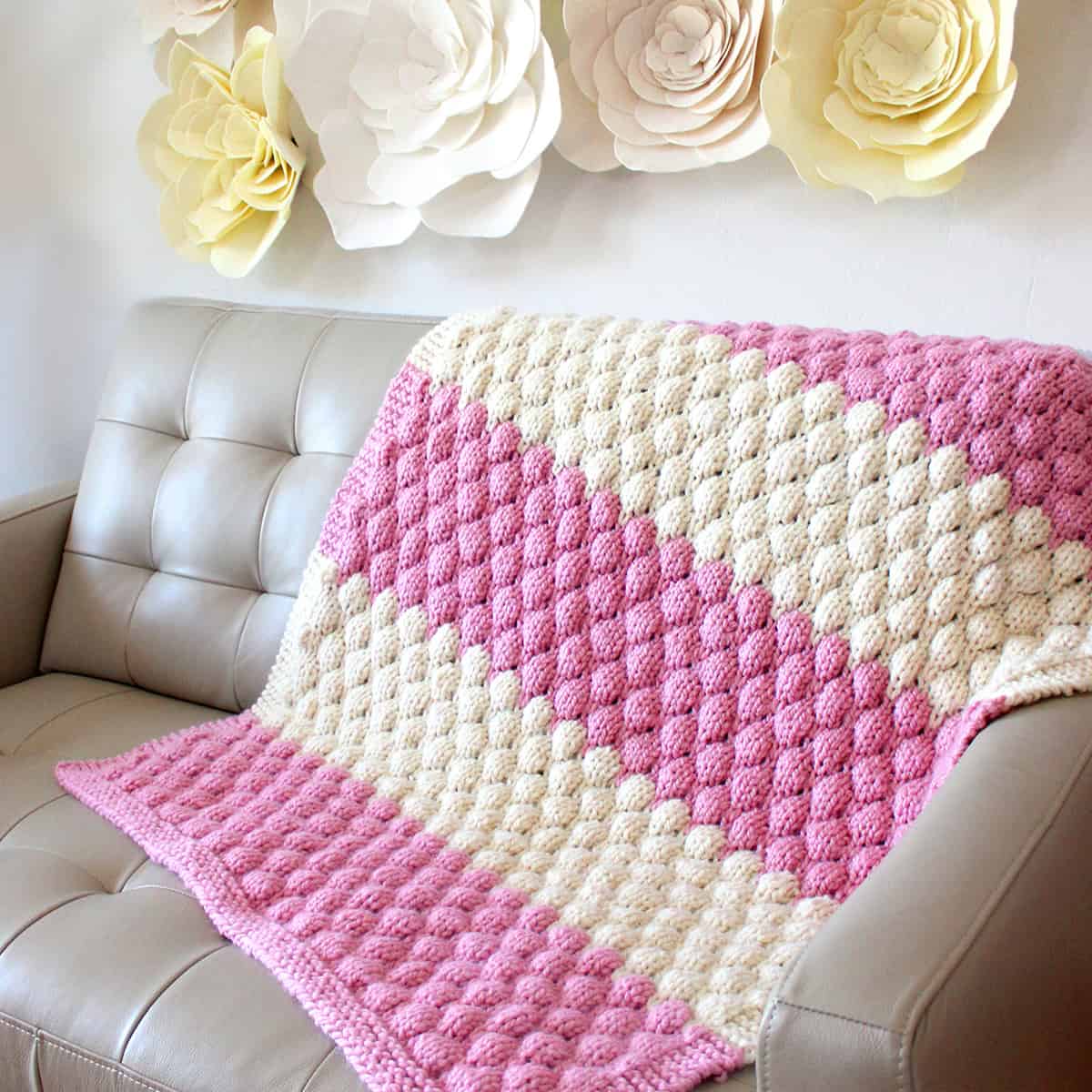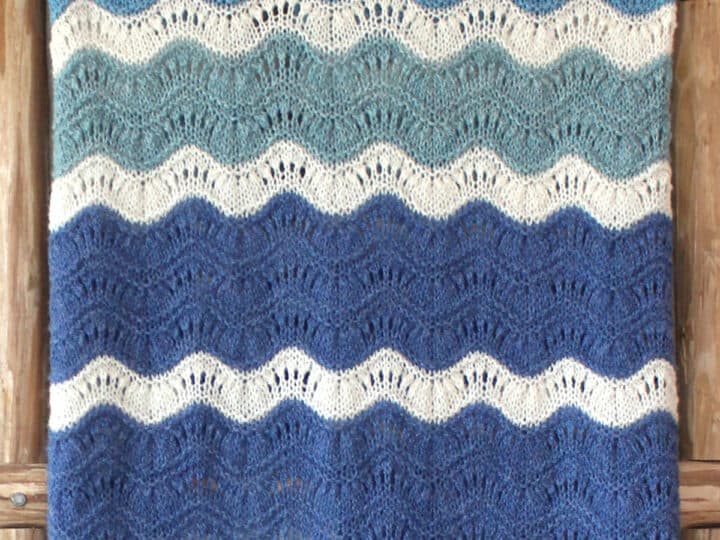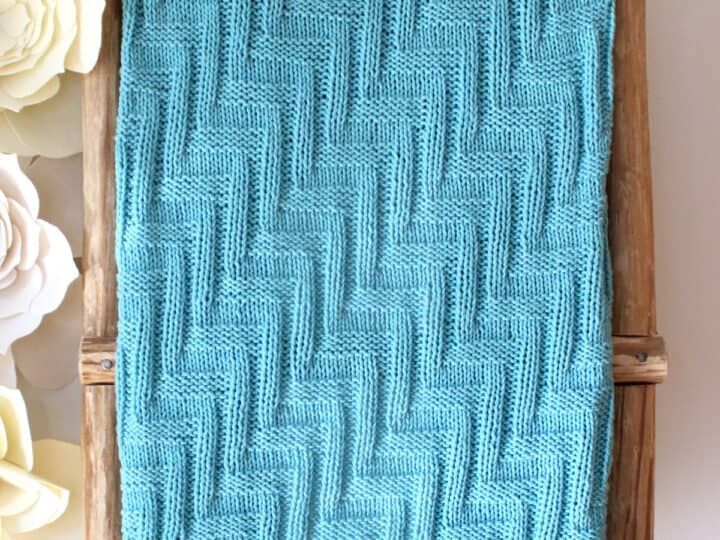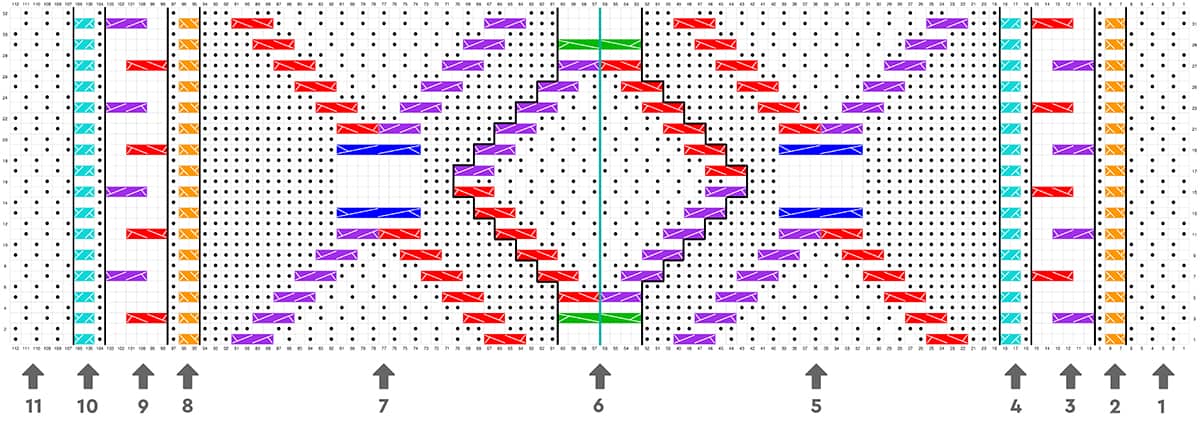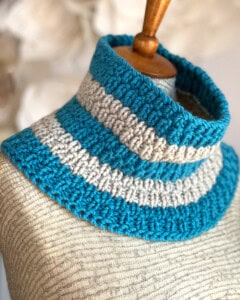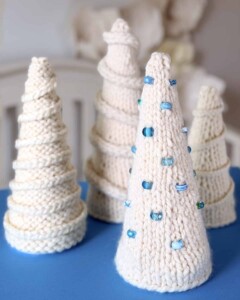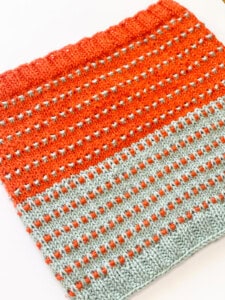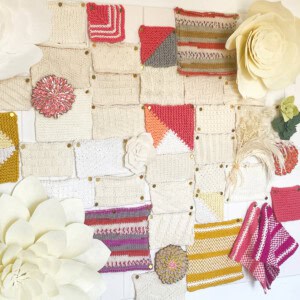Diamond Heights Cable Knit Blanket Pattern
This Diamond Heights Cable Knit Blanket Pattern creates a full-sized cozy throw your family is sure to cherish. This design features impressive twisted moss diamonds for hygge home decor. Get your free written pattern instructions with a video tutorial below.
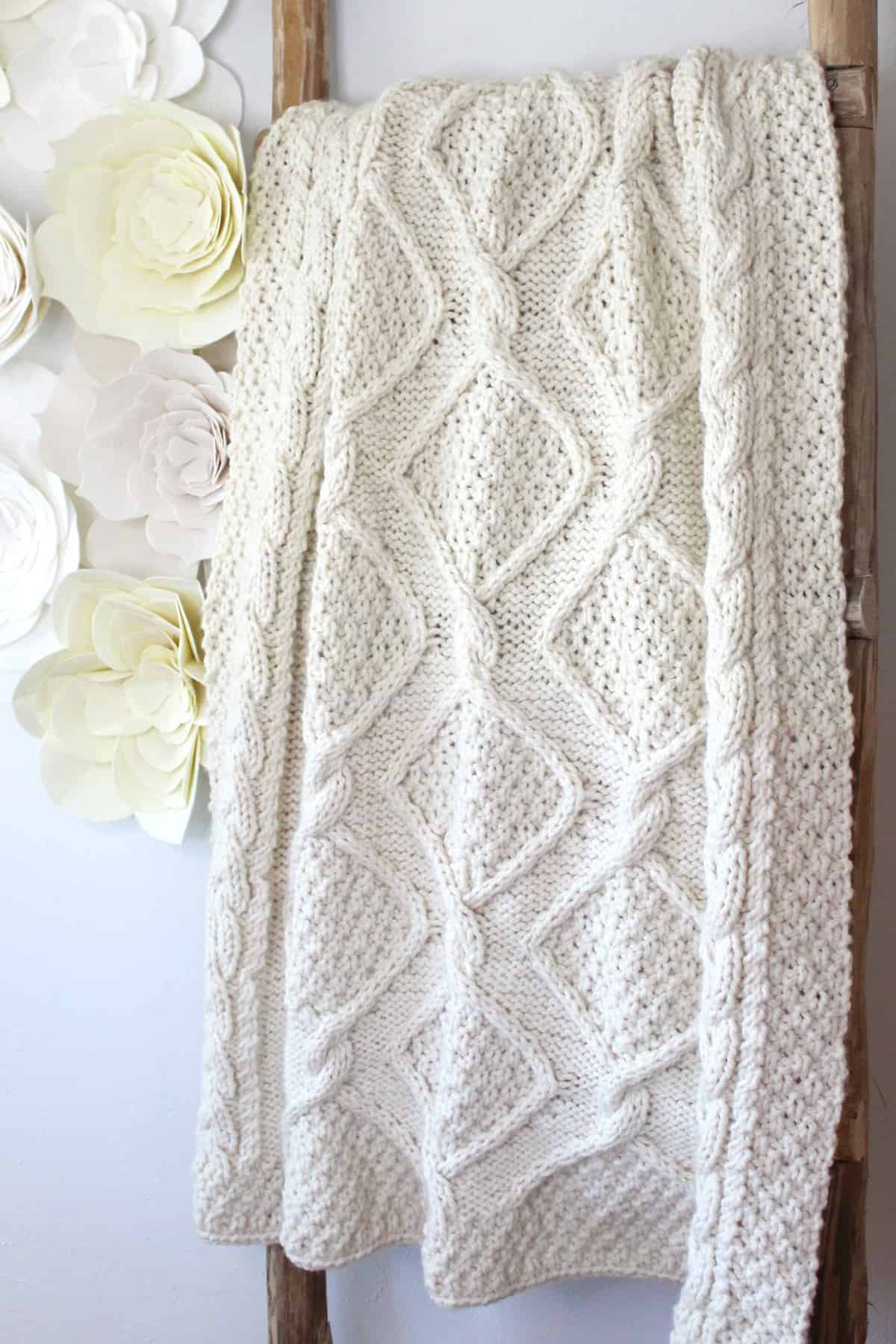
Table of Contents
Printable Knitting Pattern (ad-free)
WANT THE FREE PATTERN? Keep scrolling, it’s up next!
PRINTABLE DOWNLOAD: Purchase the 11-page ad-free printable pdf pattern in my Studio Knit Pattern Shop. Also available on LoveCrafts, and Ravelry.
Color-Coded System: There are 6 different cable stitches in this pattern. I have created a color-coded system in both the written and chart patterns to easily discern the different cable stitches at a glance. I hope it helps you, too.
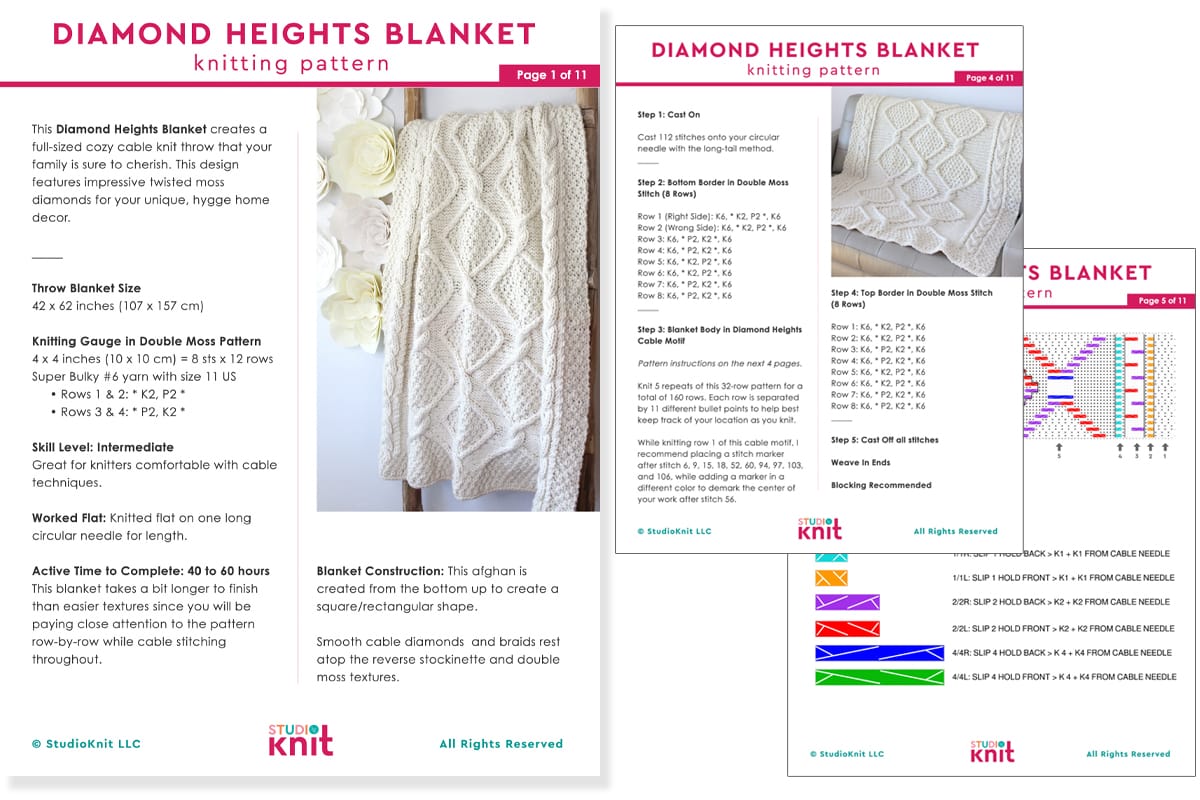
Knitted Cable Blanket Size, Gauge, and Characteristics
Throw Blanket Size is 42 x 62 inches (107 x 157 cm).
Knitting Gauge in Double Moss Pattern
4 x 4 inches (10 x 10 cm) = 8 stitches x 12 rows
Super Bulky #6 yarn with size 11 US needles
Rows 1 & 2: * K2, P2 *
Rows 3 & 4: * P2, K2 *
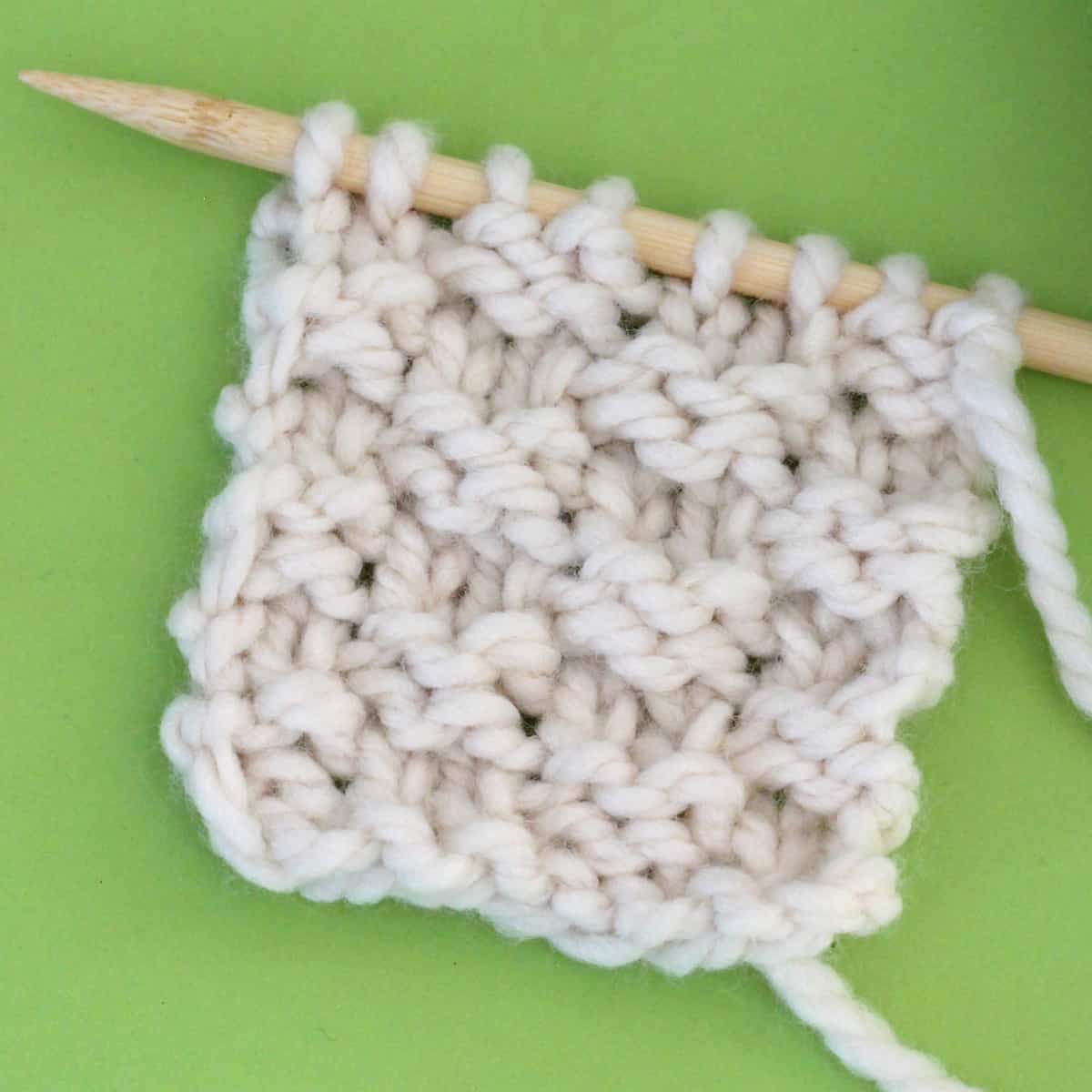
_____
Skill Level: Intermediate
Here’s an intermediate-level project for knitters comfortable with cable techniques.
_____
Active Time to Complete: 40 to 60 hours
This blanket takes a bit longer to finish than easier textures since you will be paying close attention to the pattern row-by-row while cable stitching throughout. I estimate it takes approximately 40 to 60 hours to complete, depending on your personal knitting speed.
_____
Knitting Construction
The knitted blanket is created from the bottom up and knitted flat on a long circular needle to create a square/rectangular shape. Smooth cables rest atop the reverse stockinette and double moss textures.
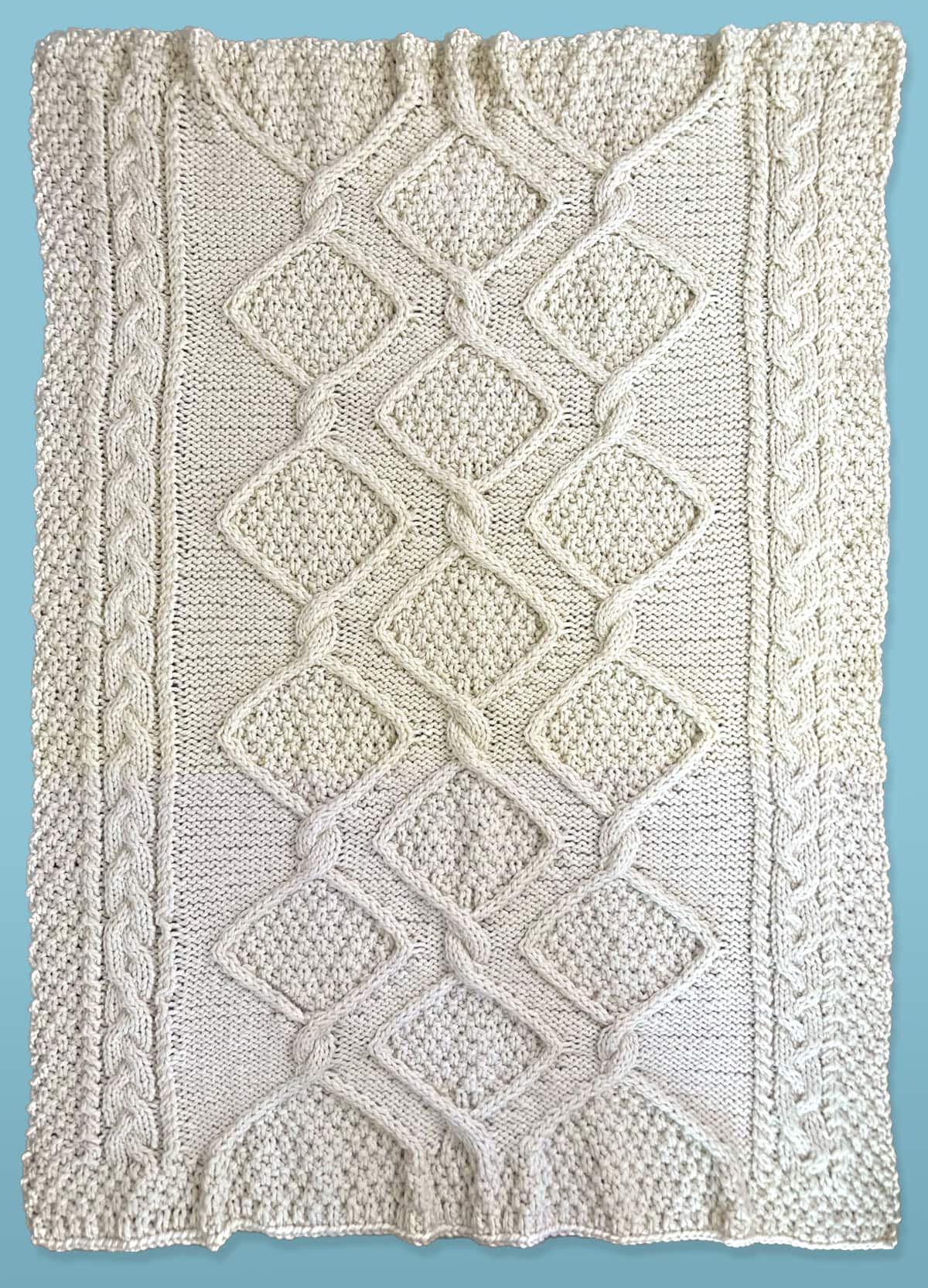
The blanket’s outer borders are knitted in the Double Moss Stitch.
Along the length of the right and left sides are designed with a thick braids nestled between rows of small rope cables.
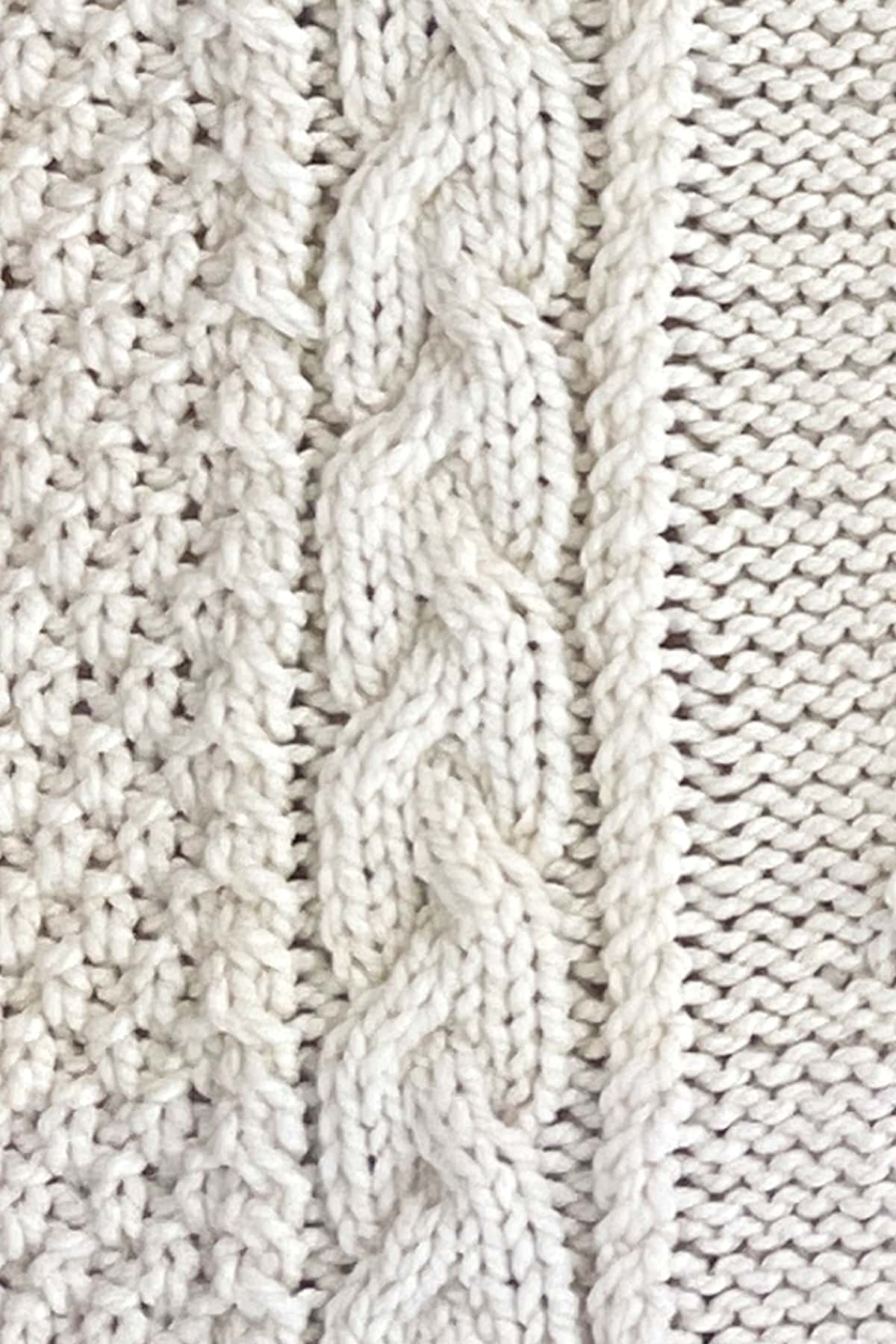
The body of our cable motif is a repeatable pattern of the Diamond Moss cable stitch. The diamond pattern rests atop a reverse stockinette background with the Double Moss stitch within. Each row of diamonds is connected by a thick twisted cable.
This blanket pattern repeats five times for the blanket length. However, you may chose to knit a different length simply by modifying the number of repeats.
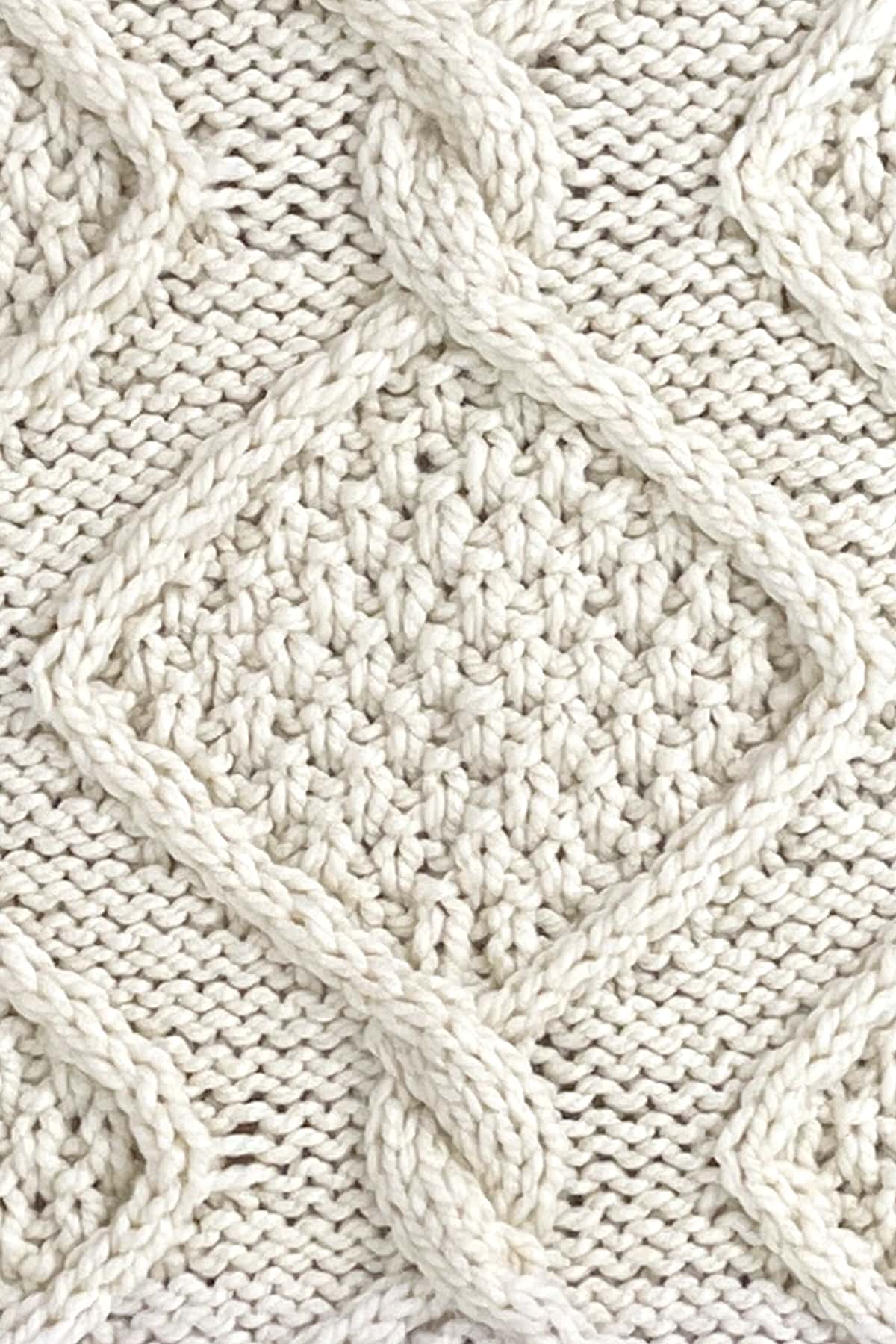
Knitting Supplies
As an Amazon Associate, I earn from qualifying purchases.
Yarn – Super Bulky Weight #6
1,054 – 1,132 yards; 1,700 – 1825 g
Recommended: Lion Brand Yarn Wool-Ease Thick & Quick Bulky Yarn
With this yarn, the entire blanket requires 11 balls at 106 yards each. I wanted to knit with a yarn blend that has the feel, warmth, and softness of wool with the easy care and washability of acrylic. It’s an affordable yarn that’s easily found in many big box craft shops here in the US. My featured sample was knit with Fisherman (natural) yarn color.
Substitutions:
- Bernat Softie Chunky, 11 balls at 108 yards each.
- Plymouth Yarn’s Encore Mega, 18 balls at 64 yards each.
Knitting Tools
- Knitting Needles Size 11 US (8 mm) – Circular 36″ or longer in length. Although this piece is knitted flat, a circular needle accommodates its length.
- Cable Needle
- Stitch Markers (I simply use yarn scraps)
- Tapestry Needle
- Scissors
Optional: - Knitting Blocks and T-Pins
- Digital Row Counter – Using row counters tutorial >
- Needle Point Protectors – How to prevent stitches from falling off your needles >
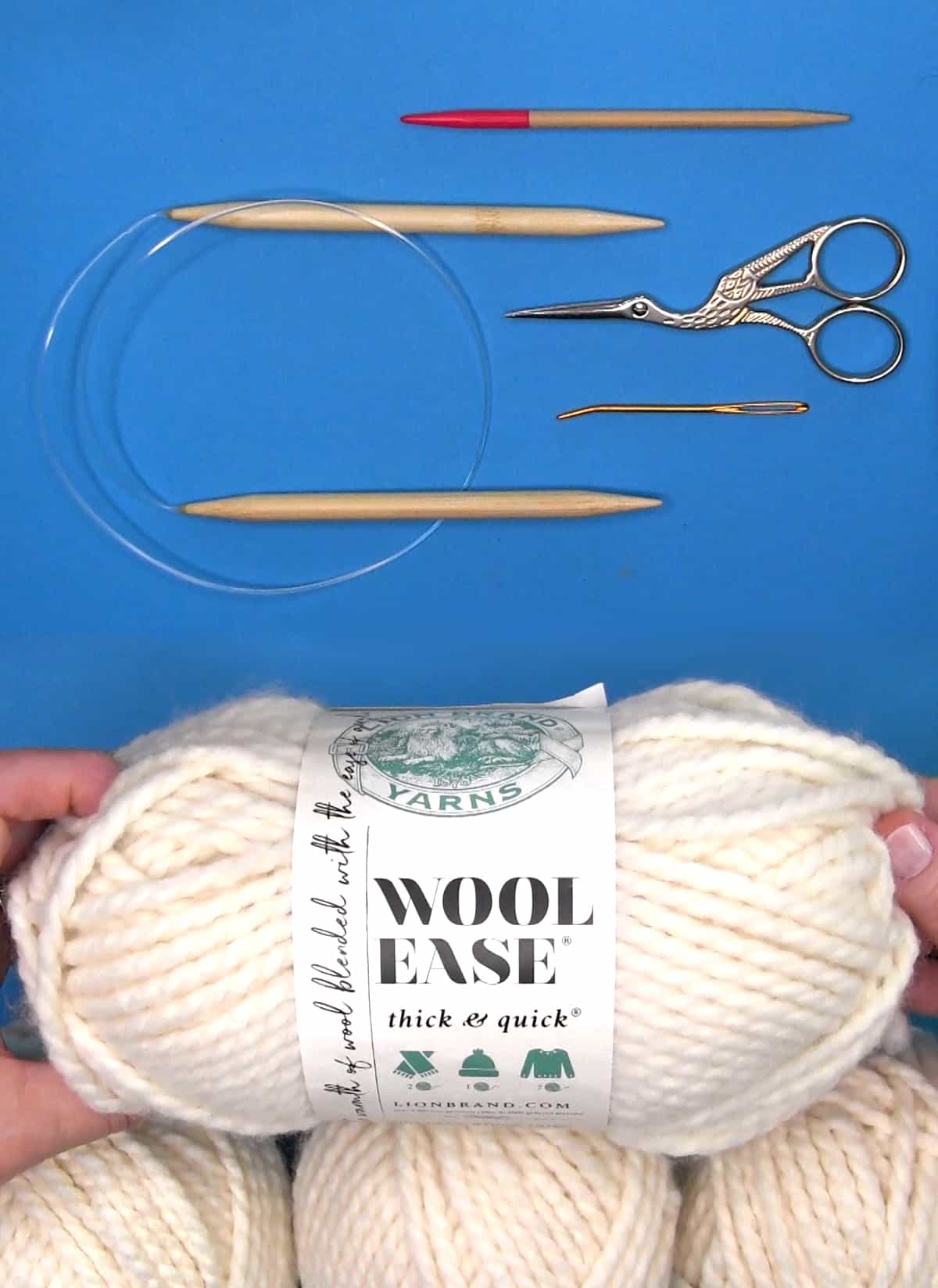
Local Inspiration of Diamond Heights
This blanket is modified from my popular Diamond Hill Loop Cable pattern to knit up a fully realized knitted project.
I found inspiration for this cable blanket from the curved streets around the natural hills in one of my favorite San Francisco neighborhoods, Diamond Heights. Located 20 miles north of my California coastside Studio Knit office, these hillsides were barren until the 1960s until this neighborhood was first developed.
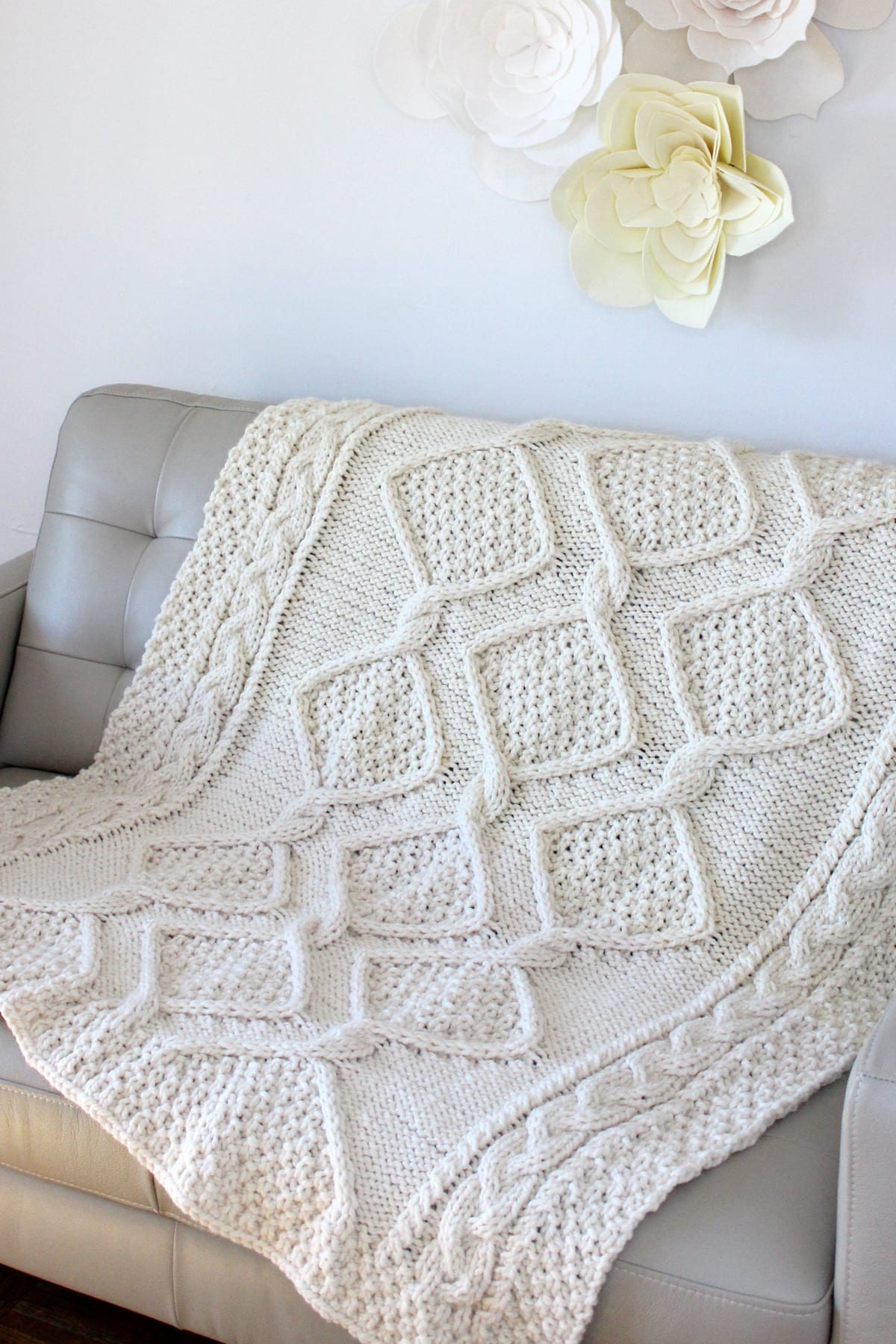
Knitting Techniques
Need to brush up or learn a new technique? Check out my entire library of Knitting Techniques to help you along as you knit up this blanket pattern.
- Slip Knot
- Cast On
- K = Knit Stitch
- P = Purl Stitch
- Cast Off
- Weave-in Yarn Ends
- 1/1R: Slip 1 and Hold Back > K1 + K1 from Cable Needle
- 1/1L: Slip 1 and Hold Front > K1 + K1 from Cable Needle
- 2/2R: Slip 2 and Hold Back > K2 + K2 from Cable Needle
- 2/2L: Slip 2 and Hold Front > K2 + K2 from Cable Needle
- 4/4R: Slip 2 and Hold Back > K4 + K4 from Cable Needle
- 4/4L: Slip 2 and Hold Front > K4 + K4 from Cable Needle
Cable Blanket Knitting Steps
Your detailed row by row knitting pattern instructions are available in the printable card further below in this post >
Step 1: Cast On
Cast 112 stitches onto your circular needle with the long-tail method.
___
Step 2: Bottom Border
Begin knitting the bottom border with 8 Rows in the Double Moss stitch.
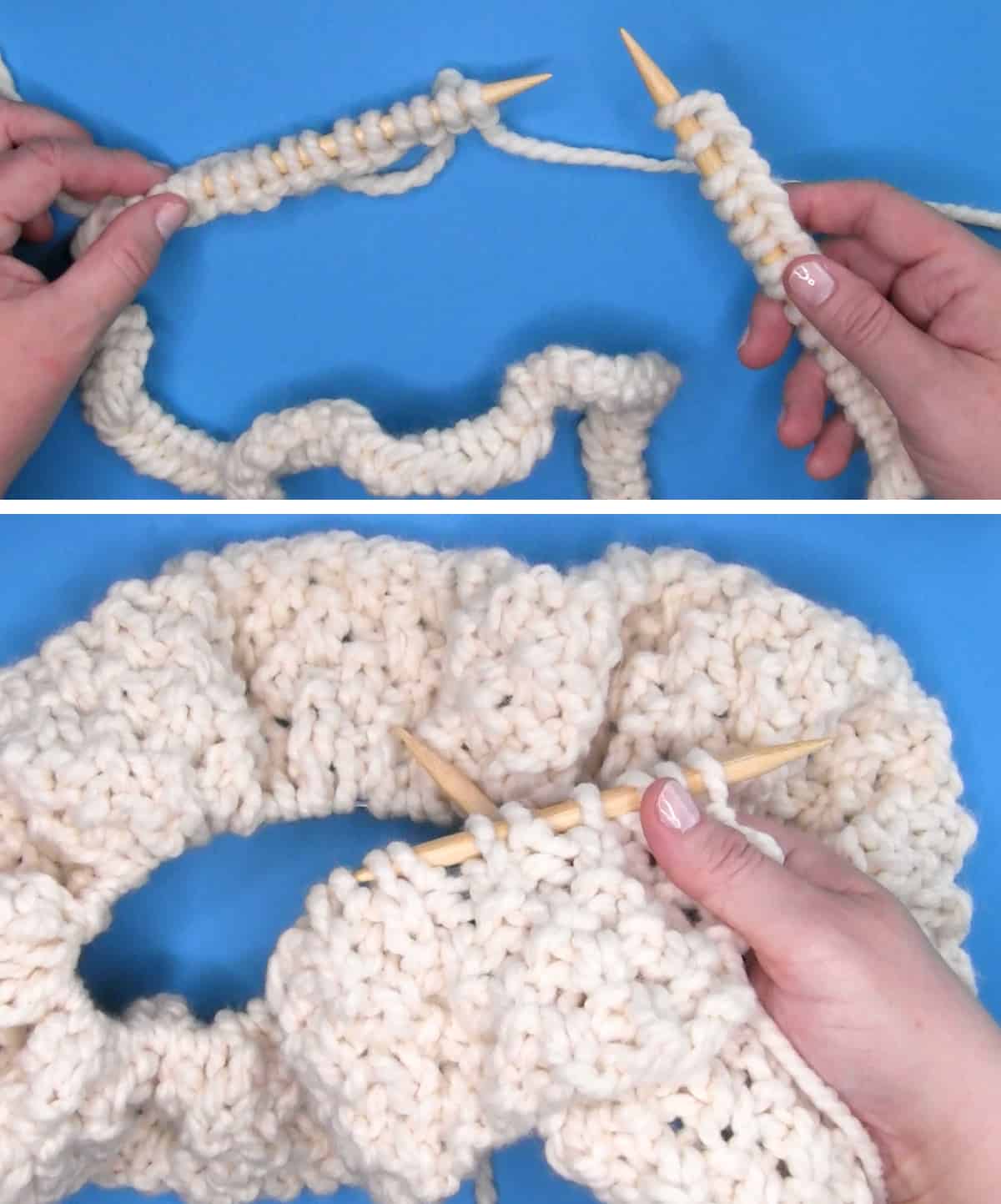
___
Step 3: Blanket Body
The Diamond Heights cable motif consists of 32 rows. Knit 5 repeats of this pattern for a total of 160 rows.
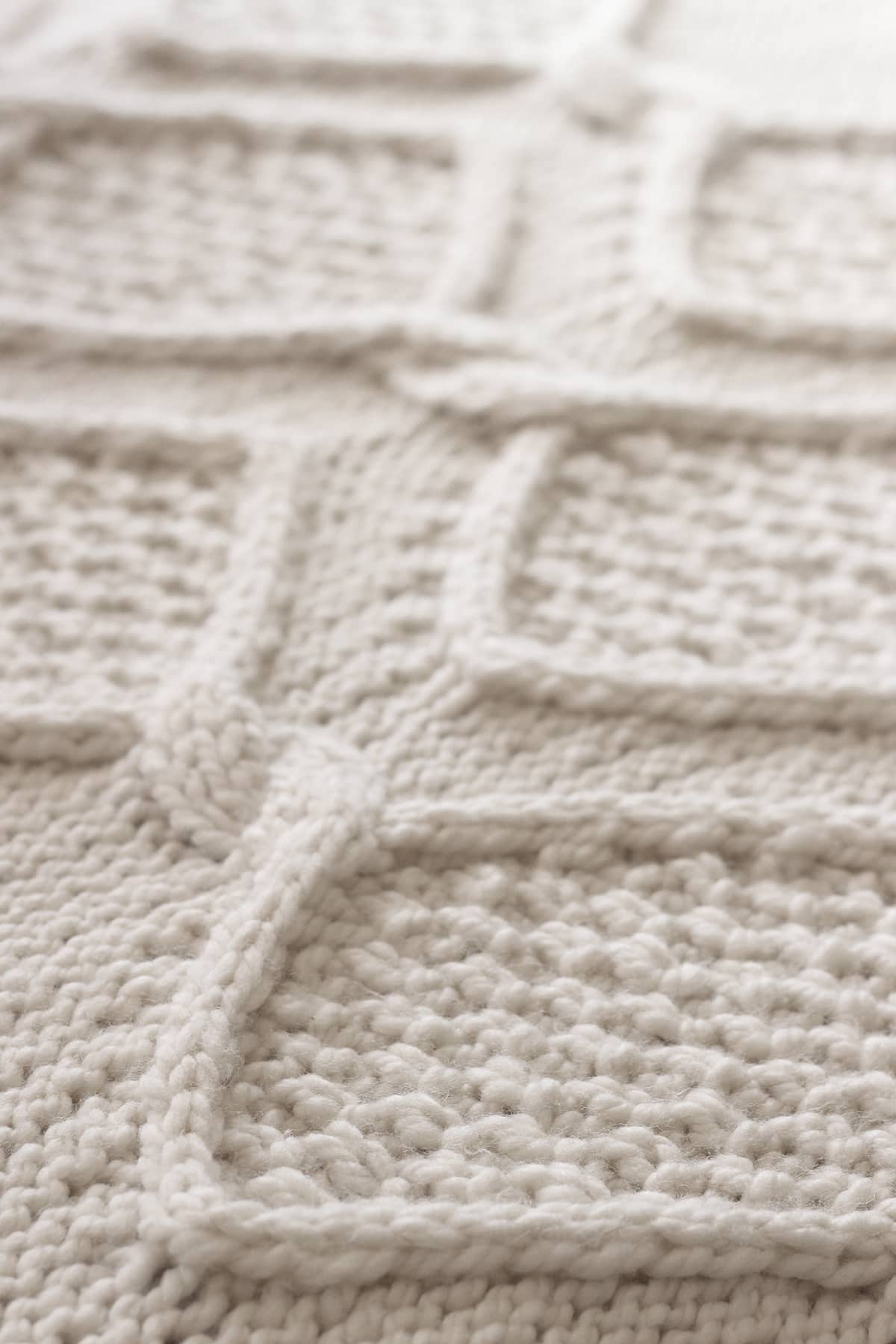
___
Step 4: Top Border
End your blanket by knitting the top border with 8 Rows in the Double Moss Stitch.
___
Step 5: Cast Off and Finish
Cast Off all stitches and Weave in your yarn ends.
Wet-blocking is recommended, but not required.
Printable Knitting Instructions
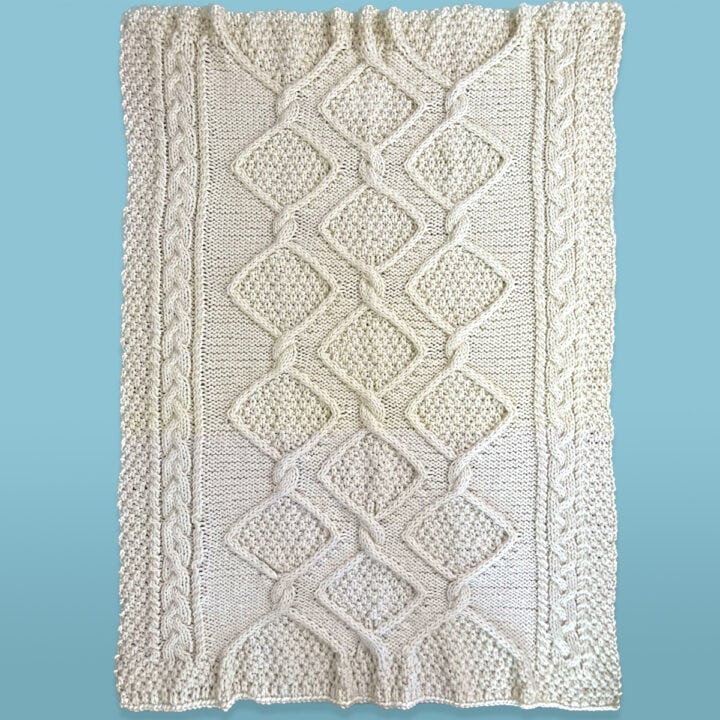
Printable Knitting Pattern
The Diamond Heights Cable Knit Blanket
Materials
- Yarn - Super Bulky Weight #6 in any fiber or color of your choice.
- 1,054 – 1,132 yards; 1,700 – 1825 g
- My sample was knit in Lion Brand Yarn Wool-Ease Thick & Quick Bulky Yarn.
- Throw Size (42" x 62") required 11 balls of this yarn brand.
Tools
- Circular Knitting Needle 11 US / 8.0 mm, 36” length
- Cable Needle
- Tapestry Needle
- Scissors
- Stitch Markers
Instructions
Step 1: Cast On
Cast 112 stitches onto your circular needle with the long-tail method.
See all knitting technique abbreviation definitions below in the Notes section.
_____
Step 2: Bottom Border in Double Moss Stitch (8 Rows)
- Row 1 (Right Side): K6, * K2, P2 *, K6
- Row 2 (Wrong Side): K6, * K2, P2 *, K6
- Row 3: K6, * P2, K2 *, K6
- Row 4: K6, * P2, K2 *, K6
- Row 5: K6, * K2, P2 *, K6
- Row 6: K6, * K2, P2 *, K6
- Row 7: K6, * P2, K2 *, K6
- Row 8: K6, * P2, K2 *, K6
_____
Step 3: Blanket Body in Diamond Heights Cable Motif (32 Rows)
Knit 5 repeats of this 32-row pattern for a total of 160 rows.
Each row is separated by 11 different bullet points to help best keep track of your location as you knit.
While knitting row 1 of this cable motif, I recommend placing a stitch marker after stitch 6, 9, 15, 18, 52, 60, 94, 97, 103, and 106, while adding a marker in a different color to demark the center of your work after stitch 56.
_____
Row 1 (Right Side):
- K1P1 (3 times)
- 1/1L, P1
- K6
- P1, 1/1R
- P3, 2/2L, P1K1 (10 times), 2/2R, P3
- K8
- P3, 2/2L, P1K1 (10 times), 2/2R, P3
- 1/1L, P1
- K6
- P1, 1/1R
- K1P1 (3 times)
_____
Row 2 (Wrong Side):
- K1P1 (3 times)
- P2, K1
- P6
- K1, P2
- K5, P2, K2, P1, K1P1 (7 times), K3, P2, K5
- P8
- K5, P2, K2, P1, K1P1 (7 times), K3, P2, K5
- P2, K1
- P6
- K1, P2
- K1P1 (3 times)
_____
Row 3:
- P1K1 (3 times)
- 1/1L, P1
- 2/2R, K2
- P1, 1/1R
- P5, 2/2L, K1P1 (8 times), 2/2R, P5
- 4/4L
- P5, 2/2L, K1P1 (8 times), 2/2R, P5
- 1/1L, P1
- 2/2L, K2
- P1, 1/1R
- P1K1 (3 times)
_____
Row 4:
- P1K1 (3 times)
- P2, K1
- P6
- K1, P2
- K7, P2, K3, P1, K1P1 (5 times), K2, P2, K7
- P8
- K7, P2, K3, P1, K1P1 (5 times), K2, P2, K7
- P2, K1
- P6
- K1, P2
- P1K1 (3 times)
_____
Row 5:
- K1P1 (3 times)
- 1/1L, P1
- K6
- P1, 1/1R
- P7, 2/2L, P1K1 (6 times), 2/2R, P7
- 2/2R, 2/2L
- P7, 2/2L, P1K1 (6 times), 2/2R, P7
- 1/1L, P1
- K6
- P1, 1/1R
- K1P1 (3 times)
_____
Row 6:
- K1P1 (3 times)
- P2, K1
- P6
- K1, P2
- K9, P2, K2, P1, K1P1 (3 times), K3, P2, K9
- P2, K4, P2
- K9, P2, K2, P1, K1P1 (3 times), K3, P2, K9
- P2, K1
- P6
- K1, P2
- K1P1 (3 times)
_____
Row 7:
- P1K1 (3 times)
- 1/1L, P1
- K2, 2/2L
- P1, 1/1R
- P9, 2/2L, K1P1 (4 times), 2/2R, P7
- 2/2R, P1K1 (2 times), 2/2L
- P7, 2/2L, K1P1 (4 times), 2/2R, P9
- 1/1L, P1
- K2, 2/2R
- P1, 1/1R
- P1K1 (3 times)
_____
Row 8:
- P1K1 (3 times)
- P2, K1
- P6
- K1, P2
- K11, P2, K3, P1, K1, P1, K2, P2, K9
- P2, K2, P1, K1, P1, K3, P2
- K9, P2, K3, P1, K1, P1, K2, P2, K11
- P2, K1
- P6
- K1, P2
- P1K1 (3 times)
_____
Row 9:
- K1P1 (3 times)
- 1/1L, P1
- K6
- P1, 1/1R
- P11, 2/2L, P1K1 (2 times), 2/2R, P7
- 2/2R, K1P1 (4 times), 2/2L
- P7, 2/2L, P1K1 (2 times), 2/2R, P11
- 1/1L, P1
- K6
- P1, 1/1R
- K1P1 (3 times)
_____
Row 10:
- K1P1 (3 times)
- P2, K1
- P6
- K1, P2
- K13, P2, K4, P2, K9
- P2, K3, P1, K1P1 (3 times), K2, P2
- K9, P2, K4, P2, K13
- P2, K1
- P6
- K1, P2
- K1P1 (3 times)
_____
Row 11:
- P1K1 (3 times)
- 1/1L, P1
- 2/2R, K2
- P1, 1/1R
- P13, 2/2L, 2/2R, P7
- 2/2R, P1K1 (6 times), 2/2L
- P7, 2/2L, 2/2R, P13
- 1/1L, P1
- 2/2L, K2
- P1, 1/1R
- P1K1 (3 times)
_____
Row 12:
- P1K1 (3 times)
- P2, K1
- P6
- K1, P2
- K13, P8, K7
- P2, K2, P1, K1P1 (5 times), K3, P2
- K7, P8, K13
- P2, K1
- P6
- K1, P2
- P1K1 (3 times)
_____
Row 13:
- K1P1 (3 times)
- 1/1L, P1
- K6
- P1, 1/1R
- P13, 4/4R, P5
- 2/2R, K1P1 (8 times), 2/2L
- P5, 4/4R, P13
- 1/1L, P1
- K6
- P1, 1/1R
- K1P1 (3 times)
_____
Row 14:
- K1P1 (3 times)
- P2, K1
- P6
- K1, P2
- K13, P8, K5
- P2, K3, P1, K1P1 (7 times), K2, P2
- K5, P8, K13
- P2, K1
- P6
- K1, P2
- K1P1 (3 times)
_____
Row 15:
- P1K1 (3 times)
- 1/1L, P1
- K2, 2/2L
- P1, 1/1R
- P13, K8, P3
- 2/2R, P1K1 (10 times), 2/2L
- P3, K8, P13
- 1/1L, P1
- K2, 2/2R
- P1, 1/1R
- P1K1 (3 times)
_____
Row 16:
- P1K1 (3 times)
- P2, K1
- P6
- K1, P2
- K13, P8, K3
- P2, K2, P1, K1P1 (9 times), K3, P2
- K3, P8, K13
- P2, K1
- P6
- K1, P2
- P1K1 (3 times)
_____
Row 17:
- K1P1 (3 times)
- 1/1L, P1
- K6
- P1, 1/1R
- P13, K8, P3
- 2/2L, K1P1 (10 times), 2/2R
- P3, K8, P13
- 1/1L, P1
- K6
- P1, 1/1R
- K1P1 (3 times)
_____
Row 18:
- K1P1 (3 times)
- P2, K1
- P6
- K1, P2
- K13, P8, K5
- P2, K3, P1, K1P1 (7 times), K2, P2
- K5, P8, K13
- P2, K1
- P6
- K1, P2
- K1P1 (3 times)
_____
Row 19:
- P1K1 (3 times)
- 1/1L, P1
- 2/2R, K2
- P1, 1/1R
- P13, 4/4R, P5
- 2/2L, P1K1 (8 times), 2/2R
- P5, 4/4R, P13
- 1/1L, P1
- 2/2L, K2
- P1, 1/1R
- P1K1 (3 times)
_____
Row 20:
- P1K1 (3 times)
- P2, K1
- P6
- K1, P2
- K13, P8, K7
- P2, K2, P1, K1P1 (5 times), K3, P2
- K7, P8, K13
- P2, K1
- P6
- K1, P2
- P1K1 (3 times)
_____
Row 21:
- K1P1 (3 times)
- 1/1L, P1
- K6
- P1, 1/1R
- P13, 2/2R, 2/2L, P7
- 2/2L, K1P1 (6 times), 2/2R
- P7, 2/2R, 2/2L, P13
- 1/1L, P1
- K6
- P1, 1/1R
- K1P1 (3 times)
_____
Row 22:
- K1P1 (3 times)
- P2, K1
- P6
- K1, P2
- K13, P2, K4, P2, K9
- P2, K3, P1, K1P1 (3 times), K2, P2
- K9, P2, K4, P2, K13
- P2, K1
- P6
- K1, P2
- K1P1 (3 times)
_____
Row 23:
- P1K1 (3 times)
- 1/1L, P1
- K2, 2/2L
- P1, 1/1R
- P11, 2/2R, K1P1 (2 times), 2/2L, P7
- 2/2L, P1K1 (4 times), 2/2R
- P7, 2/2R, K1P1 (2 times), 2/2L, P11
- 1/1L, P1
- K2, 2/2R
- P1, 1/1R
- P1K1 (3 times)
_____
Row 24:
- P1K1 (3 times)
- P2, K1
- P6
- K1, P2
- K11, P2, K3, P1, K1, P1, K2, P2, K9
- P2, K2, P1, K1, P1, K3, P2
- K9, P2, K3, P1, K1, P1, K2, P2, K11
- P2, K1
- P6
- K1, P2
- P1K1 (3 times)
_____
Row 25:
- K1P1 (3 times)
- 1/1L, P1
- K6
- P1, 1/1R
- P9, 2/2R, P1K1 (4 times), 2/2L, P7
- 2/2L, P1K1 (2 times), 2/2R
- P7, 2/2R, P1K1 (4 times), 2/2L, P9
- 1/1L, P1
- K6
- P1, 1/1R
- K1P1 (3 times)
_____
Row 26:
- K1P1 (3 times)
- P2, K1
- P6
- K1, P2
- K9, P2, K2, P1, K1P1 (3 times), K3, P2, K9
- P2, K4, P2
- K9, P2, K2, P1, K1P1 (3 times), K3, P2, K9
- P2, K1
- P6
- K1, P2
- K1P1 (3 times)
_____
Row 27:
- P1K1 (3 times)
- 1/1L, P1
- 2/2R, K2
- P1, 1/1R
- P7, 2/2R, K1P1 (6 times), 2/2L, P7
- 2/2L, 2/2R
- P7, 2/2R, K1P1 (6 times), 2/2L, P7
- 1/1L, P1
- 2/2L, K2
- P1, 1/1R
- P1K1 (3 times)
_____
Row 28:
- P1K1 (3 times)
- P2, K1
- P6
- K1, P2
- K7, P2, K3, P1, K1P1 (5 times), K2, P2, K7
- P8
- K7, P2, K3, P1, K1P1 (5 times), K2, P2, K7
- P2, K1
- P6
- K1, P2
- P1K1 (3 times)
_____
Row 29:
- K1P1 (3 times)
- 1/1L, P1
- K6
- P1, 1/1R
- P5, 2/2R, P1K1 (8 times), 2/2L, P5
- 4/4L
- P5, 2/2R, P1K1 (8 times), 2/2L, P5
- 1/1L, P1
- K6
- P1, 1/1R
- K1P1 (3 times)
_____
Row 30:
- K1P1 (3 times)
- P2, K1
- P6
- K1, P2
- K5, P2, K2, P1, K1P1 (7 times), K3, P2, K5
- P8
- K5, P2, K2, P1, K1P1 (7 times), K3, P2, K5
- P2, K1
- P6
- K1, P2
- K1P1 (3 times)
_____
Row 31:
- P1K1 (3 times)
- 1/1L, P1
- K2, 2/2L
- P1, 1/1R
- P3, 2/2R, K1P1 (10 times), 2/2L, P3
- K8
- P3, 2/2R, K1P1 (10 times), 2/2L, P3
- 1/1L, P1
- K2, 2/2R
- P1, 1/1R
- P1K1 (3 times)
_____
Row 32:
- P1K1 (3 times)
- P2, K1
- P6
- K1, P2
- K3, P2, K3, P1, K1P1 (9 times), K2, P2, K3
- P8
- K3, P2, K3, P1, K1P1 (9 times), K2, P2, K3
- P2, K1
- P6
- K1, P2
- P1K1 (3 times)
Knit 5 repeats of this 32 row pattern for a total of 160 rows.
_____
Step 4: Top Border in Double Moss Stitch (8 Rows)
- Row 1: K6, * K2, P2 *, K6
- Row 2: K6, * K2, P2 *, K6
- Row 3: K6, * P2, K2 *, K6
- Row 4: K6, * P2, K2 *, K6
- Row 5: K6, * K2, P2 *, K6
- Row 6: K6, * K2, P2 *, K6
- Row 7: K6, * P2, K2 *, K6
- Row 8: K6, * P2, K2 *, K6
_____
Step 5: Cast Off
Cast Off all stitches
_____
Weave In Ends
Blocking Recommended
Notes
Gauge: X stitches and X rows = 4 inches in Double Moss Pattern
Rows 1 & 2: * K2, P2 *
Rows 3 & 4: * P2, K2 *
_____
KNITTING TECHNIQUES
- Slip Knot
- Cast On
- K = Knit Stitch
- P = Purl Stitch
- Cast Off
- Weave-in Yarn Ends
- 1/1R: Slip 1 and Hold Back > K1 +K1 from Cable Needle
- 1/1L: Slip 1 and Hold Front > K1 +K1 from Cable Needle
- 2/2R: Slip 2 and Hold Back > K2 +K2 from Cable Needle
- 2/2L: Slip 2 and Hold Front > K2 +K2 from Cable Needle
- 4/4R: Slip 2 and Hold Back > K4 +K4 from Cable Needle
- 4/4L: Slip 2 and Hold Front > K4 +K4 from Cable Needle

Kristen McDonnell
Author • Designer • Teacher
Kristen from StudioKnit LLC produces knitting video lessons and pattern designs from her vibrant production studio on Half Moon Bay’s California coast.
Kristen McDonnell is the author of the highly acclaimed book Knit Stitch: 50 Knit + Purl Patterns featuring vintage and unique designs.

